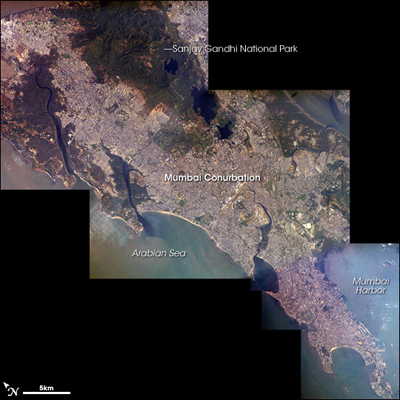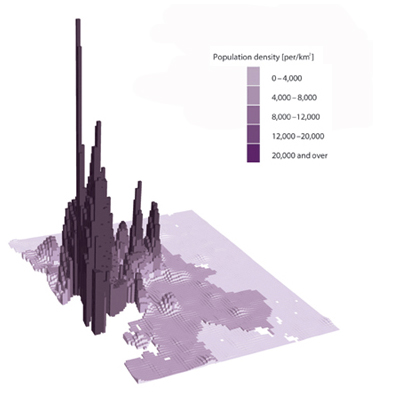Mumbai (1/3)

Photo: Tobias Mayer
Mumbai, the largest, richest, most modern and most rapidly growing city in India, is situated on India's west coast, on the Arabian Sea. Mumbai is the capital city of the state of Maharashtra and India's most important financial capital. With a population of 18.3 million people, the city ranks the fourth largest urban agglomeration in the world (after Tokyo, Mexico City and New York). Some projections state that Mumbai could overtake Tokyo as the world's largest city by 2050 (Mehta 2007, NASA Visible Earth, The Urban Age Project, UN-HABITAT 2001).

Source: NASA Visible Earth
Historically, this region was named after the local deity "Mumbadevi" and consisted of seven small islands, mostly basaltic bedrock from earlier lava flows. These islands were connected to one another by reclaimed land, but each island, or neighborhood, still retains a distinct identity within the city. The Portuguese landed in the natural port in the 16th century, naming it Bom Bahia, meaning "beautiful bay" in Portuguese. In the English colonial times starting in the 17th century, the area was called "Bombay".
Mumbai is also called the "Gateway of India" because of its large harbour and ideal location facing Africa, Europe, and the Middle East. The city's docklands comprise the largest port in the entire subcontinent, handling more than one third of the country's foreign trade (NASA Visible Earth, UN-HABITAT 2001).
In recent years, the city has reclaimed its local name "Mumbai". The city has emerged as one of India's leading commercial, economic, transportation and cultural centres, home to the country's hugely successful film industry, India's "Bollywood" and a booming stock exchange. Mumbai's skyline has often been compared to Manhattan's reflecting modern progress and potential. The city of Mumbai is generating one sixth of the gross domestic product (GDP) of India (UN-HABITAT 2001).
Known as Greater Mumbai, it covers an area of 438 km² with an extremely high population density (27,348 people per km²). Mumbai is the city with the highest population density in the world. Just adjacent to the prosperous commercial sector is Asia's largest slum, known as Dharavi (NASA Visible Earth, Petersen 2007, The Urban Age Project).

Source: The Urban Age Project
On the one hand, Mumbai is India's entertainment and financial capital, yet on the other, it is also the city with the largest slums. Traffic congestion, loss of wetlands, and flooding as well as critical housing issues and slums are key challenges facing Mumbai. But the rapid growth has also resulted in growing public health issues such as air pollution (The Urban Age Project, UN-HABITAT 2001).
New urbanized areas such as Vashi, New Bombay, Vasai, and Mahim Creek are being developed to ease this congestion and provide space for new suburbs and industrial parks (The Urban Age Project).
Task: Compare the astronaut photographs of Mumbai with the population density graph above. Where are the highest densities located in the images?
